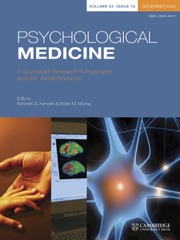Crossref Citations
This article has been cited by the following publications. This list is generated based on data provided by
Crossref.
Scherder, Erik J.A.
Eggermont, Laura
Plooij, Bart
Oudshoorn, Jeroen
Vuijk, Pieter Jelle
Pickering, Gisèle
Lautenbacher, Stefan
Achterberg, Wilco
and
Oosterman, Joukje
2008.
Relationship between Chronic Pain and Cognition in Cognitively Intact Older Persons and in Patients with Alzheimer’s Disease.
Gerontology,
Vol. 54,
Issue. 1,
p.
50.
Keeley, Thomas J.H.
and
Fox, Kenneth R.
2009.
The impact of physical activity and fitness on academic achievement and cognitive performance in children.
International Review of Sport and Exercise Psychology,
Vol. 2,
Issue. 2,
p.
198.
Woodcock, James
Edwards, Phil
Tonne, Cathryn
Armstrong, Ben G
Ashiru, Olu
Banister, David
Beevers, Sean
Chalabi, Zaid
Chowdhury, Zohir
Cohen, Aaron
Franco, Oscar H
Haines, Andy
Hickman, Robin
Lindsay, Graeme
Mittal, Ishaan
Mohan, Dinesh
Tiwari, Geetam
Woodward, Alistair
and
Roberts, Ian
2009.
Public health benefits of strategies to reduce greenhouse-gas emissions: urban land transport.
The Lancet,
Vol. 374,
Issue. 9705,
p.
1930.
Marks, Bonita L.
Katz, Laurence M.
and
Smith, J. Keith
2009.
Exercise and the Aging Mind: Buffing the Baby Boomer's Body and Brain.
The Physician and Sportsmedicine,
Vol. 37,
Issue. 1,
p.
119.
Giladi, Nir
2009.
Mobility and exercise in movement disorders.
Parkinsonism & Related Disorders,
Vol. 15,
Issue. ,
p.
S46.
Sattelmair, Jacob R.
Pertman, Jeremy H.
and
Forman, Daniel E.
2009.
Effects of Physical Activity on Cardiovascular and Noncardiovascular Outcomes in Older Adults.
Clinics in Geriatric Medicine,
Vol. 25,
Issue. 4,
p.
677.
Orgeta, Vasiliki
Regan, Ciaran
and
Orrell, Martin
2010.
Physical activity for improving cognition in older people with mild cognitive impairment.
Cochrane Database of Systematic Reviews,
McGeorge, Tristan
Cross, Sean
and
Jenkins, Rachel
2010.
Principles of Social Psychiatry.
p.
397.
Weih, Markus
Degirmenci, Ümüt
Kreil, Sebastian
and
Kornhuber, Johannes
2010.
Physical Activity and Alzheimer’s Disease.
GeroPsych,
Vol. 23,
Issue. 1,
p.
17.
Lista, I.
and
Sorrentino, G.
2010.
Biological Mechanisms of Physical Activity in Preventing Cognitive Decline.
Cellular and Molecular Neurobiology,
Vol. 30,
Issue. 4,
p.
493.
Lautenschlager, Nicola T.
Cox, Kay
and
Kurz, Alexander F.
2010.
Physical Activity and Mild Cognitive Impairment and Alzheimer’s Disease.
Current Neurology and Neuroscience Reports,
Vol. 10,
Issue. 5,
p.
352.
Steindorf, Karen
Chang-Claude, Jenny
Flesch-Janys, Dieter
and
Schmidt, Martina E
2010.
Determinants of sports, cycling, walking and overall leisure-time physical activity among postmenopausal women in Germany.
Public Health Nutrition,
Vol. 13,
Issue. 11,
p.
1905.
Aarsland, Dag
Sardahaee, Farzaneh S.
Anderssen, Sigmund
Ballard, Clive
and
the Alzheimer's Society Systematic
2010.
Is physical activity a potential preventive factor for vascular dementia? A systematic review.
Aging & Mental Health,
Vol. 14,
Issue. 4,
p.
386.
Bendlin, B.B.
Carlsson, C.M.
Gleason, C.E.
Johnson, S.C.
Sodhi, A.
Gallagher, C.L.
Puglielli, L.
Engelman, C.D.
Ries, M.L.
Xu, G.
Wharton, W.
and
Asthana, S.
2010.
Midlife predictors of Alzheimer's disease.
Maturitas,
Vol. 65,
Issue. 2,
p.
131.
Rhyu, I.J.
Bytheway, J.A.
Kohler, S.J.
Lange, H.
Lee, K.J.
Boklewski, J.
McCormick, K.
Williams, N.I.
Stanton, G.B.
Greenough, W.T.
and
Cameron, J.L.
2010.
Effects of aerobic exercise training on cognitive function and cortical vascularity in monkeys.
Neuroscience,
Vol. 167,
Issue. 4,
p.
1239.
Barak, Yoram
and
Aizenberg, Dov
2010.
Is dementia preventable? Focus on Alzheimer’s disease.
Expert Review of Neurotherapeutics,
Vol. 10,
Issue. 11,
p.
1689.
Rooks, Cherie R.
Thom, Nathaniel J.
McCully, Kevin K.
and
Dishman, Rod K.
2010.
Effects of incremental exercise on cerebral oxygenation measured by near-infrared spectroscopy: A systematic review.
Progress in Neurobiology,
Vol. 92,
Issue. 2,
p.
134.
Corabian, Paula
and
Dennett, Liz
2010.
Parkinson Disease.
p.
139.
Xu, Q.
Park, Y.
Huang, X.
Hollenbeck, A.
Blair, A.
Schatzkin, A.
and
Chen, H.
2010.
Physical activities and future risk of Parkinson disease.
Neurology,
Vol. 75,
Issue. 4,
p.
341.
張育愷
and
洪巧菱
2010.
身體活動與認知功能:對當代統合分析之回顧.
International Journal of Sport and Exercise Psychology,
Vol. 8,
Issue. 4,
p.
491.


